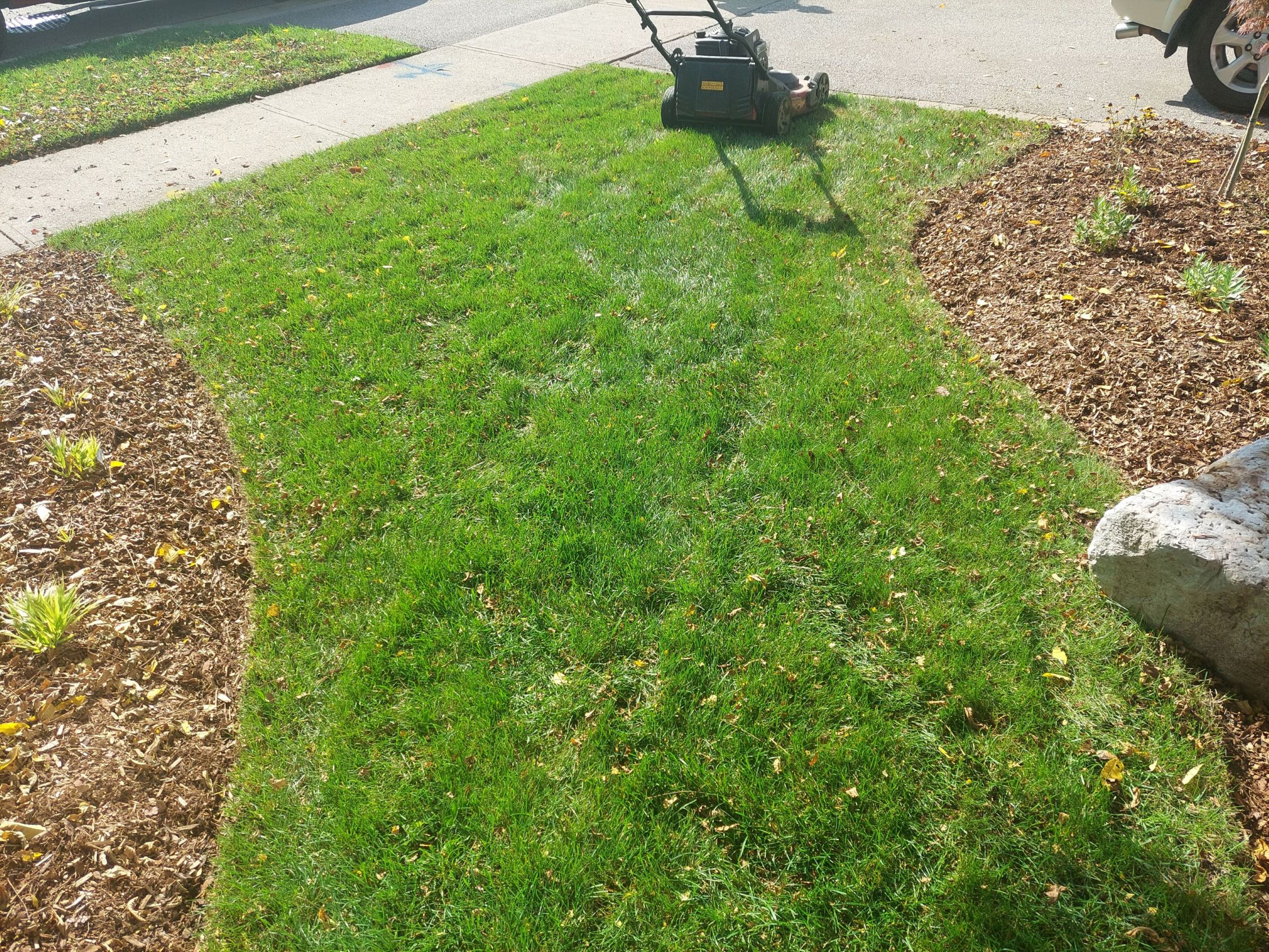Weed Barrier and why it is BAD – and doesn’t work…
AKA – Landscape Fabric, Geotextile.
And what you should do instead….
As a landscaper, I always dread each time a client asks us to install weed barrier. Landscaping brings a lot of challenges and weeds in gardens are among the greatest. Too many people think weed barriers stop weeds from growing and that is mostly false.
I belong to several Facebook pages about gardening, I am amused at the banter between people about weed barriers. There is a definite rift between those that believe in them and those that are on the good side.
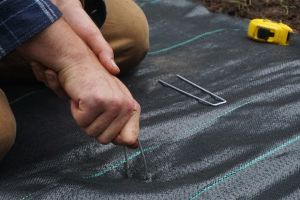
Weed barriers also harm soil, and I will explain how.
Before I go to much further, I would like to tell you I actually met the person who claims to have invented the weed barrier / landscape fabric segment of the lawn and garden industry. I am not going to name them or the company they belong to but I will tell you this. The person CLAIMS they were just trying to sell more of their geotextiles. Geotextiles are used when installing hardscaping such as pathways and patios as well as under features such as a potato stone “mulched” area.
Geotextiles prevent the native soil from migrating into the gravel base of a patio or into the potato stone mulched area. They have to her attributes as well but they aren’t meant for gardens.
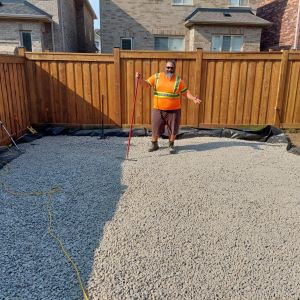
Why People Use Weed Barriers.
People hate to pull weeds.
Weeding is a task I am not really enamored with. After being in gardening as an amateur and then professional for more than 40 years I can promise you something – if there was a reliable way to prevent weeds, I would have found it by now. Weed barriers, landscape fabric – just do not work. And they harm the soil under them.
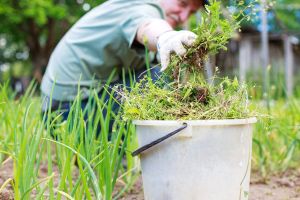
Weed Barriers Don’t Work.
As a gardener I understand that most weeds come from seeds. If we cover a garden with a weed barrier and then mulch all we are doing is MAYBE preventing existing perennial weeds from growing through. Weed seeds will still land on the mulch (or worse, the fabric itself) and germinate. Those weeds need to be removed.

If you are not diligent with removing weeds from the garden their roots will likely grow into and through the weed barrier. Once this happens pulling the weeds will also pull out the fabric. What a chore this is! Frustrating as all get out.
Spring Flowering Bulbs Won’t Grow.
Plants like tulips and daffodils are what we refer to as ephemerals. They bloom, produce their leaves and go back into dormancy very quickly. Weed barrier will prevent them from growing. No more tulips or other bulbs in the garden.
Gas Exchange. Or should I say NO gas exchange.
Using weed barrier lowers the soil’s ability to exchange gasses. Carbon dioxide is released into the soil by micro and macro organisms such as bacteria and earthworms. The increased levels of carbon dioxide will kill many of these beneficial organisms.
Why is this important? In order to explain that to you in great detail I would have to explain the entire Soil Food Web. So let me cut this class short. In order for “things” to decompose in soil the “things” need to be eaten. Macro organisms such as worms need to eat them first. Then smaller and smaller micro organisms eat them. The last 2 things to eat organic matter are bacteria and fungi.
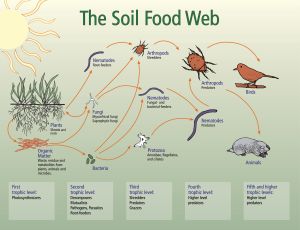
Soil bacteria will decompose organic matter into what we refer to as Plant Available Nutrients. These nutrients just sit there until they are used by plants as important mineral nutrients. There are a group of fungi called mycorrhizal fungi. These little wonders attach themselves to a plant’s roots and gather nutrients and water and give them to the plant. In return, the plant gives the fungi some sugar. A wonderful relationship that has been going on for eons.
NOT TO MENTION, plant roots need oxygen to be able to grow. With the exchange of gasses reduced, plant vigor also is reduced.
So does it make sense to cover the soil with a (likely) plastic based fabric and choke out the oxygen? I don’t think so. Without the soil biome thriving, plants will suffer. And the reverse is also true. Without plants the soil biome suffers.
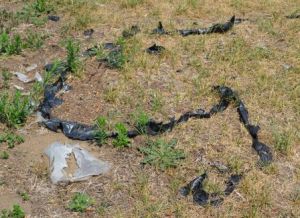
Compaction
And the soil suffers. The (not only) other thing all of these soil organisms do is hold the soil particles together. Soil is made of sand, silt and clay particles all held together with a wonderful, natural organic glue. These tiny particles are glues together into clumps soil scientists call a colloid. When these soil organisms die, the soil collapses on itself and becomes what we call compacted.
If you have ever experienced a garden that had weed barrier on it, the soil is rock hard, dead, devoid of all life.
Organic Matter
With the physical barrier of weed barrier in place, there is absolutely NO WAY for organic matter to enter the soil. No organic matter – no soil food web.
Do yourself a favour – GOOGLE “soil food web”. Read, watch, listen – you’ll be fascinated. If you aren’t fascinated or at least mildly interested, likely we can’t be friends….. Just kidding….. Sort of.
COST!!!!!
I just GOOGLED landscape fabric- weed barrier to get a price. A local garden centre has a 3’ x 25’ roll for $11.99 and a 3’ x 100’ roll for $39.99. That translates to $0.13 to $0.15 per square foot. Just for the fabric. Most times I see it used it is not used properly. It should be stapled to the ground using fabric staples, in order to keep it from moving around. What a pain!
Can’t Change Your Garden
One of the very best thing about gardening, especially perennial gardening is CHANGE! Gardens by (my) definition are dynamic, forever changing places of expression and beauty. Once you install weed barrier, your garden turns into a static display. When perennials need dividing, as they inevitably will, getting the job done with weed barrier around it, is unthinkable.
So what do I do?!?!?
Or, also called, Mulch Ado About Gardening
Mulch, mulch, mulch…..
I have another frustration as a landscape gardener. Too many people think that when we install a landscape it is a “one and done” deal. And it isn’t. Not by a long stretch.
We apply a layer of natural pine mulch that is about 2” – 3” thick. I’ll write some more about mulches at a later date but just accept we use only natural pine mulch. So a funny thing happens when you apply natural mulch to bare soil after planting a garden.
I need to back up a step. When we plant a garden we inoculate the soil with soil bacteria and mycorrhizal fungi. I wrote about the earlier in this blog. When we are creating a garden we, just through the act of planting and cultivating we destroy the soil fungi and bacteria. We restore those naturally occurring by using commercially available inoculants. You can buy them at most good garden centres.
So, we apply material to the inoculate the soil and then we apply mulch.
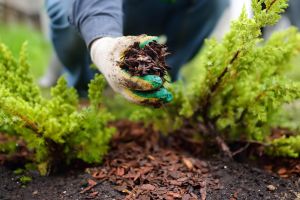
What happens? The wonderful soil biome we have helped restore immediately starts to decompose the mulch. It starts to “disappear”. Well, half true. It starts to break down. All of those wonderful macro and micro organisms start to break the mulch down.
Some of our clients are horrified to learn they need to reapply mulch every spring. Live with it. Do you want a healthy gorgeous garden? It takes work.
Back to the weed barrier thoughts. Mulch does quite a few things for the garden but let’s focus on weeds.
Mulch helps lessen the impact of weeds.
Mulch blocks out the sunlight. Many seeds need light to germinate. Therefore mulch can suppress the growth of weeds. Well, let me be honest, mulch suppresses weed growth. After a few decades of practical experience I can say, mulched beds have fewer weeds.
I am not sure if I can prove this or not but I believe few weed seeds germinate ON mulch. So the mulch will prevent some weeds from germinating. Great news, right?
When weeds do appear, they are SO EASY to deal with on a mulched bed.
Other
We had a client a few years ago with a horrible infestation of bind weed. If it is possible to hate a plant, this one is on the list. We didn’t actually do the work but coached them as to the technique.
We had them use cardboard. We had them remove all of the tape and staples and anything not actually cardboard. They put 2 or 3 layers of cardboard over their garden placing the cardboard as close to the stems of the trees and shrubs as possible. This made an impervious layer on the soil blocking out all of the light. We then had them put a very thick (too thick according to industry standards) layer of natural pine mulch. What happened is the bind weed was smothered and died. I am sure we damaged the soil biome but as the cardboard and mulch decomposed the soil recovered and the rest of the garden thrived.
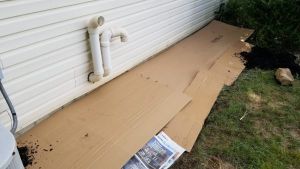
If you have a weed infested area in a garden you can also use a tarp to kill the weeds before planting. Again, this has a damaging effect on the soil but it is short term and can be rectified. Simply use a tarp to cover the area you want to use as a garden. The darker the tarp the better. Black would be best.
Cover the area to exclude the light and leave it for several weeks. Both the exclusion of light and the heat that will build up will kill all of the plants under the tarp. Please remember to add compost as well as the soil inoculants I have talked about before planting.
Finally!
One last word about weeds. By definition, a weed is any plant growing where it should not. Maybe we need to be a little more relaxed about the plants we let into our gardens. This re-defining of a plant’s nature may not sit well with everyone.
And ponder this… What a weed barrier does in exclude light from the soil to prevent weeds from growing. How else can we exclude the light? I have talked about using mulch – a great thing on so many levels.
Could we use plants? Of course! A well planted, dense garden will prevent weeds from germinating and becoming a nuisance. Soil “wants” to be covered. Once we develop a dense garden, weeds will not be a problem.
As always, if you have any comments or questions, please reach out to me. I am always ready and willing to help.
Some links to interesting articles:
The Myth of Landscape Fabric: “Landscape fabric provides permanent weed control for ornamental landscapes. https://s3.wp.wsu.edu/uploads/sites/403/2015/03/landscape-fabric.pdf
Garden Myths https://www.gardenmyths.com/landscape-fabric-weed-barrier-cloth/
Should I use landscape fabric to keep weeds out of my perennial garden? https://extension.unh.edu/blog/2019/05/should-i-use-landscape-fabric-keep-weeds-out-my-perennial-garden
Landscape fabric – a cautionary tale https://gardenprofessors.com/landscape-fabric-a-cautionary-tale/
Why Landscape Weed Barrier Fabric is Ugly & Wasteful https://gardenmentors.com/garden-help/gardening-guidelines/why-landscape-fabric-weed-barrier-wasteful/




